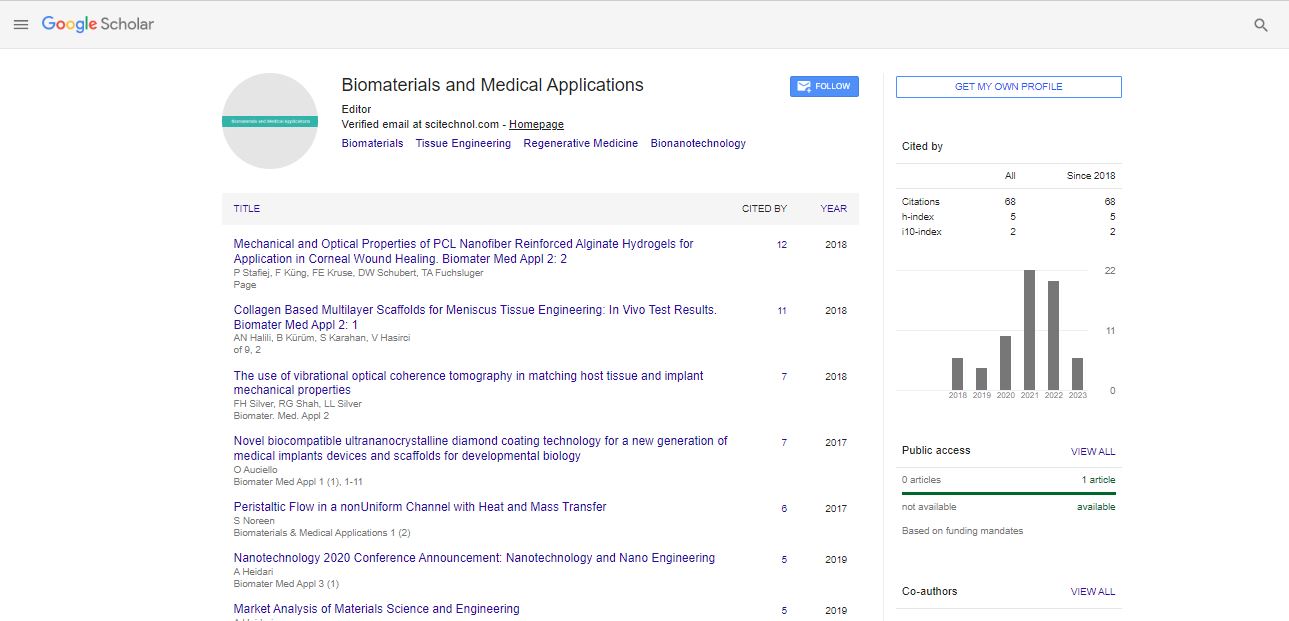Perspective, Biomater Med Appl Vol: 7 Issue: 2
Synthesis of Polymer-Drug Conjugates and Its Mechanism
Hattal Ghosh*
1Department of Pharmacy, The Maharaja Sayajirao University of Baroda, Gujarat, India
*Corresponding Author: Hattal Ghosh,
Department of Pharmacy, The Maharaja
Sayajirao University of Baroda, Gujarat, India
E-mail: hattalghosh@ac.in
Received date: 29 May, 2023, Manuscript No. BMA-23-106745;
Editor assigned date: 31 May, 2023, PreQC No. BMA-23-106745(PQ);
Reviewed date: 14 June, 2023, QC No. BMA-23-106745;
Revised date: 21 June, 2023, Manuscript No. BMA-23-106745(R);
Published date: 28 June, 2023 DOI: 10.35248/2577-0268.100515.
Citation: Ghosh H (2023) Synthesis of Polymer-Drug Conjugates and Its Mechanism. Biomater Med Appl 7:2.
Abstract
Description
Polymer-drug conjugates have emerged as a promising strategy for improving the delivery and therapeutic efficacy of drugs. By combining the unique properties of polymers and pharmaceuticals, these conjugates offer enhanced drug solubility, stability, controlled release, and targeted delivery. The conventional administration of drugs often faces limitations such as poor solubility, rapid degradation, non-specific distribution, and low bioavailability. Polymer-drug conjugates provide a solution to these challenges by exploiting the tunable properties of polymers to enhance drug delivery systems. Polymers can serve as carriers or scaffolds for drug molecules, protecting them from degradation, prolonging their circulation time, and facilitating their targeted delivery to specific tissues or cells.
Selection of polymers for conjugation
The choice of polymer is important for the successful synthesis of polymer-drug conjugates. Polymers must possess certain properties, such as biocompatibility, biodegradability, controlled drug release, and facile conjugation chemistry. Commonly used polymers include Polyethylene Glycol (PEG), Poly Lactic-co-Glycolic Acid (PLGA), Poly N-Iso Propyl Acrylamide (PNIPAM), and polyamidoamine dendrimers. Each polymer offers unique advantages and can be tailored to meet specific drug delivery requirements.
The conjugation of drugs to polymers can be achieved through various methods, including physical encapsulation, covalent linkage, and self-assembly. Physical encapsulation involves the entrapment of drug molecules within polymer matrices or nano-carriers. Covalent linkage, on the other hand, involves the formation of a stable chemical bond between the drug and polymer. Common covalent conjugation strategies include the use of reactive functional groups on the polymer or drug, such as amino, carboxyl, or thiol groups, which can react with corresponding groups on the drug or polymer.
Controlled drug release
Controlled release of drugs from polymer-drug conjugates is an important aspect of their design. By manipulating the polymer structure, drug release kinetics can be finely tuned to achieve sustained or triggered release profiles.
Factors influencing drug release include the polymer composition, molecular weight, degradation rate, and drug loading. Techniques such as physical entrapment, hydrolysis, enzymatic degradation, pHsensitive linkages, and temperature-responsive polymers are employed to achieve controlled drug release.
Targeted delivery
Targeted delivery of drugs using polymer-drug conjugates allows for increased drug accumulation at the desired site, minimizing offtarget effects and reducing systemic toxicity. Strategies for achieving targeted delivery include the incorporation of targeting ligands, such as antibodies, peptides, or aptamers, onto the polymer surface. These ligands can selectively bind to receptors or antigens overexpressed on the target cells or tissues, facilitating active uptake of the conjugate. Passive targeting can also be achieved through the Enhanced Permeation and Retention (EPR) effect, wherein the conjugate preferentially accumulates in tumor tissues due to their leaky vasculature.
Applications
The field of polymer-drug conjugates continues to evolve rapidly, driven by ongoing research and technological advancements. Recent developments include the use of nanotechnology, such as polymeric nanoparticles and micelles, for improved drug delivery. Additionally, the integration of stimuli-responsive polymers allows for triggered drug release in response to specific environmental cues, such as changes in pH, temperature, or enzyme activity.
Polymer-drug conjugates have found application in a wide range of therapeutic areas, including cancer, infectious diseases, cardiovascular disorders, and neurodegenerative diseases. For example, anticancer polymer-drug conjugates have shown enhanced efficacy by selectively delivering cytotoxic agents to tumor cells while sparing healthy tissues. Similarly, antimicrobial polymer-drug conjugates have demonstrated improved antimicrobial activity and reduced resistance development.
Conclusion
The synthesis of polymer-drug conjugates represents a promising strategy to overcome the limitations of conventional drug delivery systems.
By combining the unique properties of polymers and pharmaceuticals, these conjugates offer improved drug solubility, stability, controlled release, and targeted delivery. The selection of appropriate polymers and conjugation methods, along with a deep understanding of drug release kinetics and targeting strategies, are important for the successful design of polymer-drug conjugates. Ongoing advancements in this field hold great potential for the development of innovative and effective drug delivery systems that can revolutionize the field of therapeutics.
